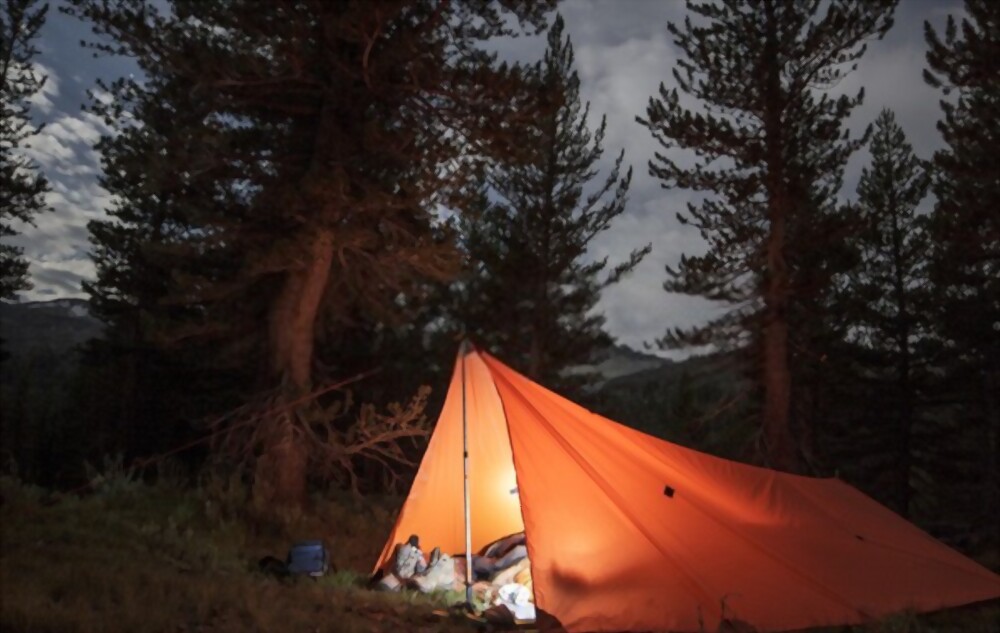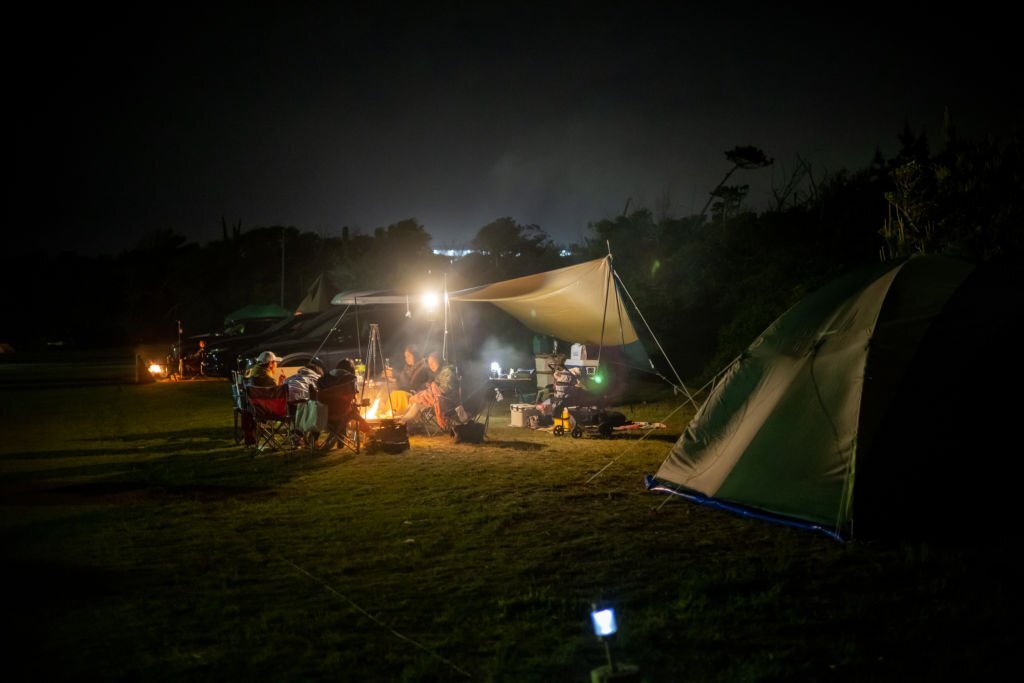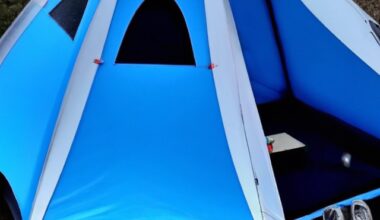For most people, the perfect camping trip includes time spent outdoors enjoying nature. However, if you don’t have the right gear, your camping trip can quickly go from perfect to disastrous. Usually, people will prefer the best camping tent, However, having a good camping tarp is one of the most important pieces of gear you can have, and choosing the right one can mean the difference between a great trip and a bad one.
What is a Camping Tarp?

A camping tarp, just like a camping tent, is a waterproof and durable sheet of material that can be used as a ground cover or shelter when camping. It is typically made from polyester or nylon and can be bought in a variety of sizes to suit different needs.
A camping tarp can be an essential piece of gear for any camper, as it can provide protection from the rain and wind, and help to keep your campsite clean and dry.
What is the Difference Between a Camping Tarp, A Camping tent and Hammock?
A camping tarp is a piece of waterproof or water-resistant material that can be used as a groundsheet or to provide shelter from the rain. Poly tarps are often used in conjunction with a tent to provide an extra layer of protection from the elements.
A camping tent is a portable shelter that is made from fabric and poles, and is used for sleeping or storage. A backpacking tent is a portable shelter that is typically made of canvas or other waterproof material. A tent footprint acts as a protective barrier beneath your tent, absorbing damage and preserving the tent floor. An ultralight tent can also be used for car camping.
A hammock is a hanging bed or chair made of fabric, rope, or netting. Hammocks are usually suspended between two points, such as trees, and are used for sleeping or relaxing.
Hammock camping entails replacing your traditional tent with a hammock and a few useful accessories, allowing you to sleep comfortably outside.
What are the Benefits of Using a Camping Tarp?
A camping tarp is an essential piece of equipment for any camper as much as a sleeping bag. It is an extremely versatile piece of equipment that can offer many benefits to campers. Perhaps the most obvious benefit is the protection it can provide from the elements, whether rain, sun, or wind.
It can also be used as an emergency shelter if your tent or hammock is damaged or destroyed by mother nature.
Additionally, a tarp tent can be used to create a makeshift kitchen area or dining area with your camp stove, or even just a place to relax in the shade.
There are endless possibilities for what a camping tarp can be used for, making it an essential piece of gear for any serious camper.
The Different Types of Camping Tarps
There are different types of camping tarps available on the market, and each has its own set of features and benefits. There are different types of camping tarp materials depending on what you need the tarp for.
If you need a tarp for shelter, you will want a waterproof and durable material. If you need a tarp for a ground cover, you will want a lighter-weight material. There are also tarps made specifically for sun and wind protection.
Here is a look at some of the most popular types of camping tarps:
- The canopy tarp: This tarp is designed to provide shelter from the sun and rain. It is usually made from waterproof and UV-resistant material and can be easily set up using poles or trees.
- The ground tarp: This tarp is designed to protect your camping gear from the ground. It is usually made from durable and waterproof material and can be easily staked down.
This will prolong the life of your tent by preventing moisture from penetrating it and soaking your belongings. No matter how tough the floor is, the abrasive ground will wear it out, so the tent is protected by a ground cover or tarp.
- The privacy tarp: This tarp is designed to provide privacy while you are camping. The privacy tarp is a great addition to any camping trip. It provides a sense of privacy and security while you are away from home. It is made of durable materials that will last for many camping trips. This tarp is easy to set up and take down using a trekking pole, and it is compact enough to fit in your backpack.
4. Flat Tarp camping tarp: The Flat Tarp camping tarp is the ideal tarp for backpackers and hikers who want a versatile, durable and lightweight tarp. Made of high quality materials, this tarp shelter is perfect for use in all kinds of inclement weather and terrain.
How to Choose the Best Camping Tarp For Your Next Outdoor Experience

There are a few factors to consider when purchasing a camping tarp. When it comes to finding the best camping tarp for your needs, the sun is one of the most important factors to consider. If you want a tarp that will provide shelter from the sun, then you need to find one that is made from a material that will reflect the sun’s rays.
Secondly, consider the tarp size. A tarp that is too small won’t provide enough coverage, while a tarp that is too large will be difficult to carry. It is important to choose a tarp size that is large enough to cover your intended camping area.
Thirdly, you need to think about the material the tarp is made from and the weight. Heavy-duty tarps like the Kelty Noahs Tarp, Hyperlite Mountain Gear, Sea to Summit Escapist tarp and Big Agnes camping tarps, are great for rough conditions and are more durable, but they can be difficult to carry. Whereas lighter tarps are easier to carry and set up, they don’t offer as much protection.
Finally, consider the price of the tarp. A more expensive tarp will likely be made of higher quality materials and will last longer. Though such a tarp might cost more upfront, it will likely save you money in the long run.
What are the Best Tarps for Camping
Top camping tarps are made of high-quality materials that can withstand all weather conditions. They are also lightweight and easy to carry, which makes them ideal for camping trips.
When choosing a tarp, make sure to select one that is the right size for your needs and that has all the features you need, such as grommets, loops, and reinforced corners.
As an avid camper, I’ve used my fair share of tarps. In my opinion, the best camping tarps come from brands like:
- Coleman camping tarp
- Kelty camping tarp
- REI camping tarp
- Sierra Designs
- The North Face
- WhiteDuck Super Heavy Duty Poly Tarp.
- Trademark Supplies White Tarp Cover.
- 3 Amazon Basic Waterproof Camping Tarp.
- 2 B-Air Grizzly Tarps.
- KING-A-MA-JIGS Waterproof Plastic Tarp.
Materials to Consider When Choosing A Camping Tarp
If you are looking for camping tarp materials, there are a few things to consider. Polyethylene, Nylon, Silnylon, Cuben Fiber, and Tyvek are among the materials used to make various types of camping tarps.
What is the Most Durable Waterproof Tarp??
There is no definitive answer to this question as it depends on a number of factors, including the intended use of the tarp and the conditions it will be exposed to. However, some materials that are commonly used for waterproof tarps include polyethylene, PVC, and canvas. Polyethylene is often considered to be the most durable option, as it is resistant to both UV and extreme temperatures. PVC is also a durable option but can become brittle in cold weather. Canvas is a classic choice for a waterproof tarp, but needs to be treated regularly with a water repellent in order to maintain its water resistance.

How Do You Maintain Your Camping Tarp
Maintaining your camping tarp is important to extend its lifespan and keep it functioning properly. Inspect it regularly for rips, holes, and tears, and patch or sew up any damage.
If your tarp has grommets, make sure they are all intact and not pulling out. If you use your tarp often, consider giving it a good cleaning every few months to prevent mildew and dirt buildup. With proper care, your camping tarp can last for many seasons.
Conclusion
In conclusion, the best tarp is designed for summer camping. They are waterproof, lightweight, easily transportable, and durable. They can be used for a variety of activities such as camping, hiking, boating, and painting.



